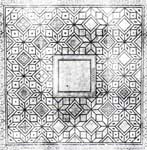
Excavation of the chateau revealed Roman foundations. Visible in this picture is the gallery of the Apocalypse, with the grande salle comtale to the right.
Roman Anjou

Despite the heroic resistance of the Gauls, the Romans easily conquered the area north of the Alps through their superior military training and discipline. Roman influence is not always visible in the Angevin landscape, but the Roman administrative center known as "Juliomagus" is the foundation of modern Angers. This town of 9,000 people possessed the full complement of Roman buildings and other infrastructures. Like most planned Roman cities, Juliomagus has two great axes: the decumanus maximus is the now the rue Saiint-Aubin, and the cardo maximus is formed by the rues Saint-Evroult, Chanoine Urseau, Saint-Laud et Cornet.
The ruins of the amphitheater were extante until the 19th century. It was located between the rue Hanneloup and rue Bressigny and remembered in the street name rue des Arenes. The modern reconstruction of the city has occasioned numerous discoveries of old Roman foundations. The baths have been located in the present quartier République. A mosaic found in excavations of the Place du Ralliement. These spots are circled on this map of Angers.
Five hundred years of Roman rule produced striking consequences for Gaul. Politically, the idea was planted of citizenship of a common state with a single set of laws and administrators and a more or less unified tax system. In practice, much localism remained, and the direct and indirect taxes were assessed and collected inequitably. If imperial Rome benefited by holding provincial Gaul (from financial exactions, manpower, and cheap grain), the Gauls also derived economic advantage from their connection. Security against barbarians and bands of brigands encouraged the Gauls to clear more forests and farm more lands. Better roads, bridges, and communications fostered greater trade. Towns and villages began to appear in place of the mud-hut habitations.
 |
Excavation of the chateau revealed Roman foundations. Visible in this picture is the gallery of the Apocalypse, with the grande salle comtale to the right. |
This page was meant to be viewed in frames. |
 Return to Return toAmelia Carr's Home Page |